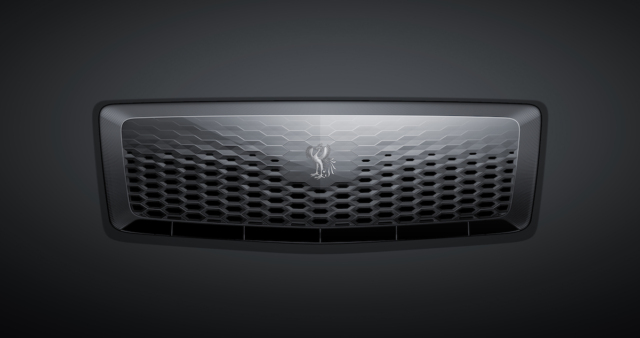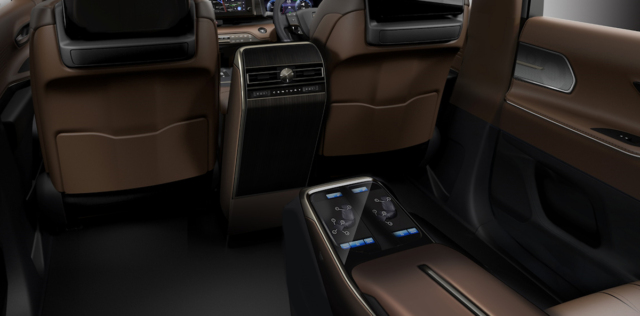The dust is still settling from Toyota’s Century SUV bombshell, and strong opinions will continue to reverberate for some time. In the meantime, thanks to some design illustrations we can glimpse what those who worked on the car originally imagined. It’s not uncommon for there to be a huge chasm between what a designer intends and what is practical for packaging and production, but we can’t help but feel some opportunities were missed.
Our biggest complaint about the styling is that the Century SUV looks rather short and stubby from the side. Illustrations by exterior designer Ryota Nakai show a longer, wider body with muscular flanks and powerful stance. Proportionally it has a much longer hood, giving the car a decidedly rear-wheel-drive posture. Of course, the Century SUV uses a transversely-mounted V6 with plug-in hybrid system, so in reality the hood doesn’t need to be so long.
We prefer the DRLs that form a C-shape across the two levels of headlight and taillight. They seem to be a bit more cohesive than the actual lights, which just seem like four elements stacked on a spacious shelf. Incidentally, on the finished car the turn signal is mounted on the downward-facing surface of the horizontal divider, and can’t be seen until it illuminates, unless you know where to look.
Another illustration by exterior designer Shota Asano is even more extreme. There’s probably no way a greenhouse like that could truly house passengers in comfort, the raison d’etre of the Century SUV, but it looks cool and imposing in a Blade Runner way.
In the finished car the upper and lower levels of the headlights and taillights connect, but we think they look better as separate elements. We also like the thin line that spans the width of the rear to connects each level of taillight. It’s a shame none of these details made it to the production car.
The interior is where it counts, and that’s where the Century SUV is particularly well thought out. You’ll notice there is no pass-through in the front passenger seatback because the rear seat reclines nearly completely flat, a “world’s first”, Toyota claims. The seatback is curved concavely to maximize legroom.
It even comes with its own shoehorn, as one might expect to take one’s shoes off when entering the Century SUV, as one would when entering a home. There’s good reason too, as one certainly wouldn’t want to get sidewalk filth in the ultra-dense pile of the optional tango dantsu floormats.
Interior designer Takaaki Kato says that the top of the instrument panel was drawn as to blend in with the scenery. There’s an enormous screen, but it doesn’t stick up above the dash, and there’s nothing but a single vent to the left of it. Many of the physical buttons for the chauffeur are placed out of sight from the rear passengers, who shall not be bothered by the actions of the driver.
One final note: Though we’ve been referring to the car as the Century SUV, the actual name is just plain “Century” exactly like the sedan’s. This was apparently at the insistence of Akio Toyoda. Both are Centurys as far as Toyoda is concerned. Both will be sold a select Toyota dealerships by “Century Meisters”, a specially trained group of salespeople with “extensive knowledge of the Century brand”.
The Century sedan will continue to be sold alongside the Century SUV, for now. Those who remember Toyota history might recall that the company also sold a RWD Corolla alongside the newly introduced FWD Corolla as well in the mid-80s, before dropping the FR platform altogether for the FF one. Time will tell where the future of the Century lies.
Additional Images:
Images courtesy of Toyota.



































Design is always subjective. You make some very good points on styling differences that could have made it to the final design. It should be noted the the profile of greenhouse on the final design is lifted almost exactly from the sedan with some changes to the rear door glass. I think that is why the back end looks a bit truncated (no pun intended). Overall I think the final design is fine especially since it is a vehicle people want to be in not necessarily be seen in.
I agree about the greenhouse. I think it looks great. The stubbiness I think comes from the ratio of vertical body height vs the length of the wheelbase and hood.
I think the critical lengths are (i) the front overhang (ii) the distance from the trailing edge of the front wheelarch to the leading edge of the front door (iii) the distance from the trailing edge of the rear door to the leading edge of the rear wheelarch (iv) the rear overhang.
In a car with FR proportions, these go short, long, short, long in sequence; the lead sketch in the article shows these proportions.
A car with FF proportions has long, short, long, short.
The actual Century SUV has long, short, short, long – so it looks like the wheelbase is a bit short for the body, hence the dumpy look I think. It’s like the Bentayga in this.
Incidentally Toyota’s Mirai is an example of an FF car with FR proportions (based on a Crown but the electric motor drives the front wheels).
I suspect the only way to get the noble proportions that would be appropriate for a Century would be to adapt an FR platform. In any case, I suspect the next Century/ies of both kinds will be pure battery EVs.
Excellent breakdown. I rather like design of the Mirai/Crown, probably because it’s fooling my brain.
I have overlaid the supplied concept profile, this link:
https://i2.wp.com/JapaneseNostalgicCar.com/wordpress/wp-content/uploads/2023/09/ToyotaCenturySUV-sketch05.jpg
And the linked black production model from this link:
https://japanesenostalgiccar.com/wordpress/wp-content/uploads/2023/09/ToyotaCenturySUV-13.jpg
Only processing was H-flipping the black car, scaling down the higher res concept drawing and positioning one over the other. Toggling layer visibility and sliding opacity of the production car confirms the differences.
Note the wheel size and wheelbase appear the same.
The difference I see is the sides of the production car are taller, with the result of a higher roofline. The rear is also slightly longer, makes sense for practicality reasons. The front is much the same, with the production car having a slightly extended lower bumper section.
So yeah, concept car was a chop-top!
Thanks for doing this! It’s incredible how much something like that can trick the eye.
And not a single Toyota cow brand in sight, only the Century phoenix.